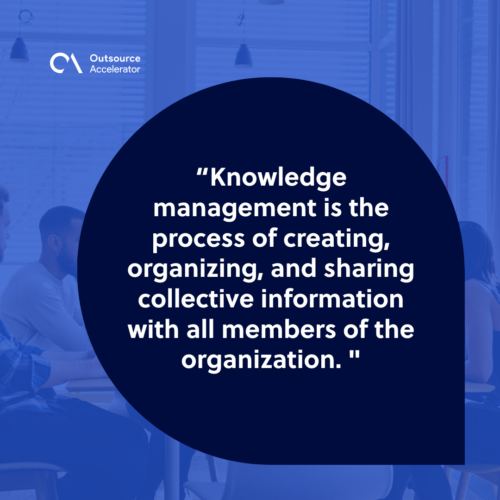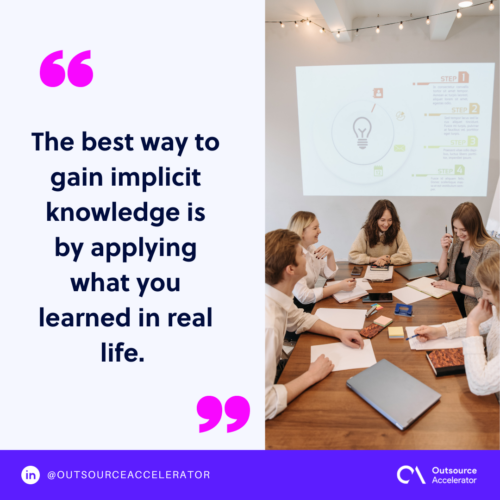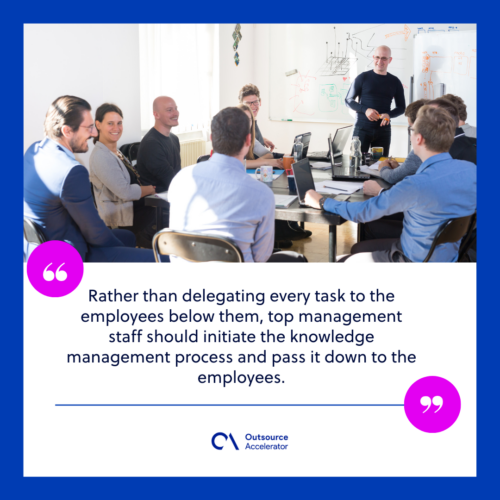Harnessing the power of knowledge management

In the modern, information-driven world, knowledge management is crucial to maintaining business operations.
Having clear access to company knowledge keeps all employees and managers informed and on the same page, leading to increased efficiency and guidance in making decisions.
Learn more about how knowledge management works and how you can apply it to your company in this article.
What is knowledge management?
Knowledge management is the process of creating, organizing, and sharing collective information with all members of the organization.
This is done with a knowledge management system, where information is stored in one giant database, making it easy to access and use for operational purposes.
Knowledge can be organized into different categories depending on the company’s needs. Having knowledge ready at any moment increases productivity and speeds up accomplishing business objectives.

Benefits of knowledge management
When done correctly, knowledge management brings several benefits to the business. Here are some ways it can help you succeed:
Streamlined operations
Knowledge management is an integral part of company operations as it streamlines certain processes, making it easier and more efficient for employees to fulfill their goals.
Everyone saves a lot of time sifting through information because everything they need is readily available for use.
With knowledge management, you have a singular source of truth; you do not have to conduct multiple searches just to find one piece of data.
Enhances collaboration
When all members of the organization have access to relevant knowledge, it becomes a lot easier to work together.
Employees can collaborate effectively now that they have matching information to work with. They can create and achieve common goals and build a sense of trust with each other.
Informed-decision making
Decisions are no longer based on assumptions or illogical reasoning. With the right data, companies can use it to find patterns and create insights that will lead to an informed decision.
Knowledge transparency helps unite all employees, ensuring they are all on the same page and working together to make the best decisions possible.
Reduces clutter and unnecessary data
Knowledge management also involves organizing data into easy-to-understand categories. Doing so keeps things neat and reduces data clutter and outdated information.
Clearing your system of unnecessary information also makes space for new, relevant information. Updating your knowledge also reduces the risk of working with inaccurate data.
Prevents information silos
Information silos are a form of data mismanagement that involve separating data or keeping it restricted from other departments. Doing so prevents smooth communication between information systems.
Knowledge management is the solution as it eases the flow of information and communication. Having all important data in one place for everyone to access allows for easier coordination.
Types of knowledge management
Knowledge is not limited to factual data or numbers. It also includes one’s personal skills and taking the things they’ve learned and sharing them with others.
Listed below are some common types of knowledge management:
Tacit knowledge
Tacit knowledge is also known as personal knowledge. This refers to information specific to an individual’s experiences and skills.
Examples of tacit knowledge include how a person feels during a specific instance or the inherent skills developed over time.
This type of knowledge is usually difficult to translate into words as it is specific to one person. However, it is still useful information to keep track of as individual experiences can help create ideas and accomplish goals.
Employees can help each other develop their tacit knowledge by sharing personal experiences and how they handle certain situations.
Implicit knowledge
Implicit knowledge involves skills learned over time after taking in a certain amount of information from elsewhere.
For example, you might read a guide on how to perform a certain task. However, can you say you know how to do it after just reading about it?
The best way to gain implicit knowledge is by applying what you learned in real life. Only by practicing and perfecting what you read can you say that you have truly learned something.
This also applies to knowledge management as it allows the company to take note of new things you have learned that could be useful for future projects.

Explicit knowledge
Explicit knowledge refers to hard, factual information that typically cannot be refuted. This includes statistics, reports, instructions, or manuals.
This knowledge is the easiest to track as it is objective, not specific to an individual, and can simply be written down, printed, and categorized accordingly.
Declarative knowledge
Declarative knowledge is similar to explicit knowledge in that they are both static information on a certain thing or topic that can easily be recorded and accessed.
This type of knowledge answers who, what, when, and where questions, which helps the individual make sense of the subject matter.
An example of declarative knowledge can be objective details about the company, such as when it was established and who its leaders are.
3 steps to implementing knowledge management
Knowledge management can be broken down into three main steps:
Knowledge identification
The process starts with identifying and acquiring information from various sources, such as employees, outside the organization, or reading materials. Knowledge can be acquired through research or it can be accidental or unintentional.
Part of this step is seeing how these different pieces of information help the company in achieving their goals. Employees must figure out how this data will be used and what scenarios are applicable to them.
Additionally, in order to maintain efficiency, this data must be new and undocumented. Any form of fresh knowledge is better for the company to move forward.
Knowledge organization
The next step is structuring your information in a way that is easy to understand. The more organized information is, the easier it will be to work with.
You can segment information into similar patterns or different categories, whichever makes it easier for the knowledge management system to use.
Remember to implement appropriate security measures for this information, as it must only be accessed by those within the organization.
Knowledge distribution
The final step of knowledge management is distribution. It is a form of knowledge transfer that involves sharing information with other departments of the company.
Sharing this information with those essential to reaching company goals is important. Other departments that can benefit from this include training teams, marketing, or even those outside relevant departments to remain transparent.
It is then up to those teams and the organization leaders to utilize the data they are given and use it to make decisions and execute strategies to improve results.
Strategies to improve knowledge management
There are several knowledge management strategies to attain the most desirable results.
Goal-setting
Setting clear goals will give the information you have gathered a purpose. For example, if your overall goal is to increase sales, you will need the necessary knowledge needed to achieve this.
Once you realize what all the information you have gathered is for, it will be a lot easier to work with and strive toward that end goal.
Creating a knowledge-sharing policy
A structured knowledge-sharing policy allows your information to stay within the company and prevents important data from being lost.
This policy formalizes and gives structure to your data, making it more organized and easy to follow, regardless of churn rate or department.
Appointing key leaders in knowledge management
Knowledge can sometimes be mishandled, or employees can get lost in trying to utilize it. Therefore, appointing someone to spearhead the knowledge management process is key.
This person is experienced in handling different data and fully understands the company’s objectives. The appointed leader must possess the necessary skill set to guide the employees toward handling information correctly.
Lead by example
It is up to the managers and supervisors to set a good example of proper knowledge management to their employees.
Rather than delegating every task to the employees below them, top management staff should initiate the knowledge management process and pass it down to the employees.
This allows workers to learn from their managers until they are ready to spearhead the process with minimal supervision.
Applications of knowledge management
Enterprises can apply knowledge management in many ways if they have the relevant data to help them.
Some of these applications include the following:
Training and onboarding
Knowledge management can help ease new employees by addressing their skill gaps and learning curves.
New hires do not have to be overwhelmed with high amounts of information. Thanks to proper knowledge management, the company will provide them with the necessary resources.
Customer service
Customers want answers to questions immediately, and knowledge management reduces the amount of time spent looking for these answers.
This allows businesses to move quickly from one customer to the next, increasing efficiency and leading to happier customers.
Improving clarity with knowledge management
Knowledge management is a powerful tool that simplifies the process of achieving company goals. It guides organizations to make informed decisions derived from facts and personal experiences.
Otherwise, businesses would be making baseless decisions that could harm their operations. Having every decision backed up with the necessary knowledge is always better.








 Independent
Independent




